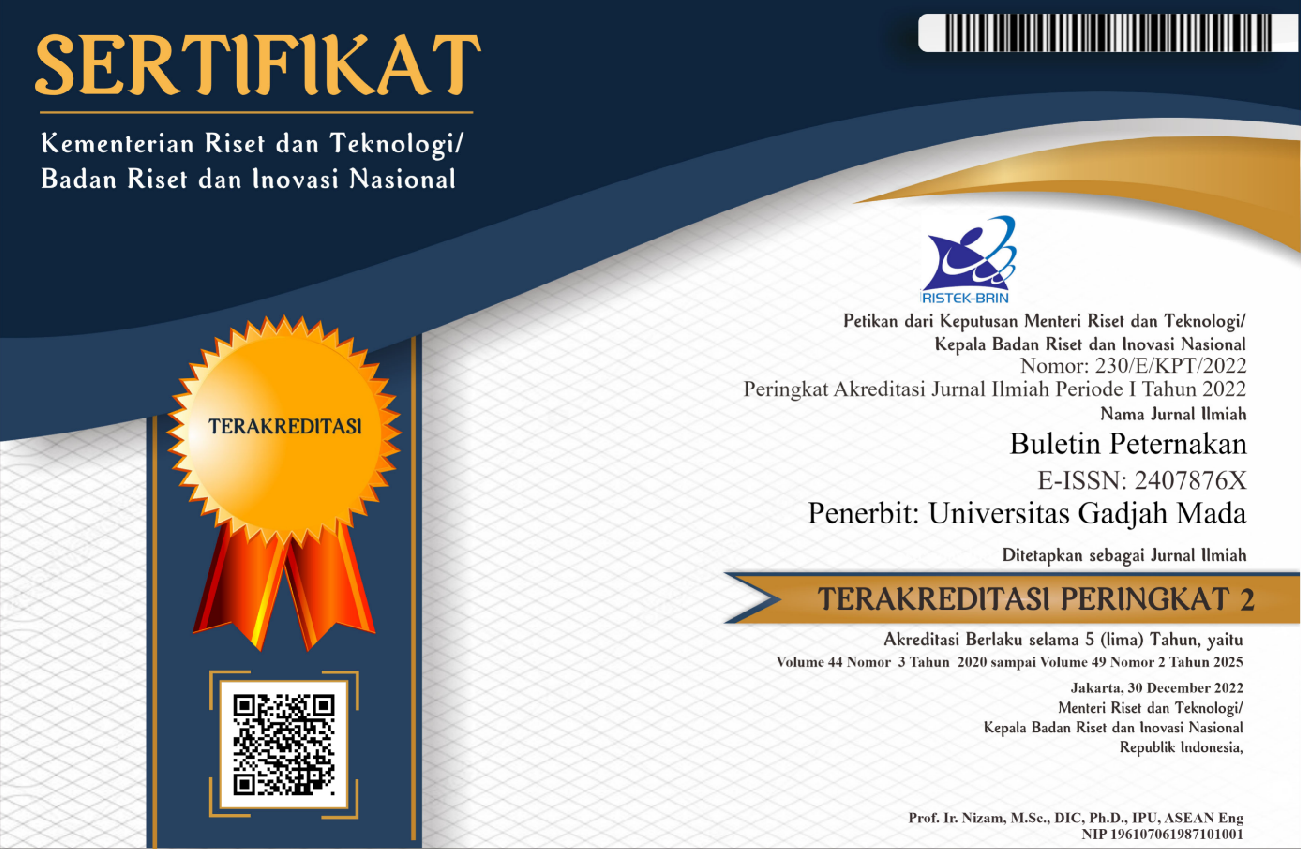A Multi-Dimensional Approach to the Sustainable Development of Moa Buffaloes in Maluku Province, Indonesia
Jomima Martha Tatipikalawan(1*), Fransiskus Trisakti Haryadi(2), Endang Sulastri(3), Tri Satya Mastuti Widi(4)
(1) Faculty of Agriculture Universitas Pattimura
(2) Faculty of Animal Science Universitas Gadjah Mada
(3) Faculty of Animal Science Universitas Gadjah Mada
(4) Faculty of Animal Science Universitas Gadjah Mada
(*) Corresponding Author
Abstract
The purpose of the study was to determine the level of sensitivity of the indicator for the sustainability of the Moa Buffalo development based on the results of the identification and measurement of the index with a multidimensional approach on ecological, socio-cultural, and economic dimensions. The unit of analysis in this study, which was conducted on Moa Island, Maluku Province, was 261 farmer households and 16 experts who were selected using purposive sampling technique. Data collection method: literature study, Focus Group Discussion, in-depth interview, survey, measurement. The research variable is the development potential of the Moa Buffalo from 3 dimensions of sustainable Moa Buffalo development (ecology, socio-culture, economy), including 40 indicators. Data analysis using ordination technique Rap-BANGKER through the Multi-Dimensional Scaling (MDS) method to measure the index and status of sustainability and Leverage Analysis, to determine the key factors, Monte Carlo Analysis to assess the effect of errors on the estimated value of ordination for the development of the Moa Buffalo. The results showed that the average value of the Moa buffalo development index was 52.72% (sustainable). The ecological dimension is 41.15% (less sustainable) with 7 sensitive indicators, socio-cultural dimension is 60.28% (sustainable) with 5 sensitive indicators, economic dimension is 56.73% (sustainable) with 3 sensitive indicators. The Monte Carlo analysis of the three dimensions shows the value of the sustainability index at the confidence level of 95%, the difference in value is <1, the coefficient of determination (R2) for the third dimension is 95.00%. The MDS Rap-BANGKER analysis model is adequate to estimate the sustainability of the development of Moa Buffalo, has a high level of confidence, can be used as an evaluation tool to rapid appraisal sustainability analysis of buffalo development in an area.
Keywords
Full Text:
PDFReferences
Asriany, A. 2016. Local wisdom in buffalo breeding system Desa Randan Batu Kabupaten Tana Toraja. Buletin Nutrisi dan Makanan Ternak 12: 64-72.
Budiyanto, K. 2011. Typology of cow dung utilization in an effort to support organic farming in Sumber Sari village, Poncokusumo sub-district, Malang Regency. J. Gamma F 1: 42-49.
Cassidy, A. and B. Mcgrath. 2015. Farm, place and identity construction among irish farm youth who migrate. Journal of Rural Studies 37: 20-28.
FAO. 2004. Carbon Segugstration in dryland soil. Http://www.fao. org/aocrep/ 007/ y5738c/ y5738e00.htm. Accessed 21 Mei, 2019.
Farahdiba, A. A., A. Ramdhaniati, and E. S. Soedjono. 2014. Technology and management of the biogas program as one of the sustainable alternative energies in Malang Regency. Jurnal Inovasi dan Kewirausahaan 3: 145-159.
Fauzi, A. 2013. Sustainability analysis through rapid appraisal and multidimensional scaling (RAP+/MDS). Natural Resources and Environmental Management Study Program, Postgraduate School, Bogor Agricultural University, Bogor.
Fauzy, A. and S. Anna. 2005. Permodelan Sumberdaya Perikanan dan Kelautan untuk Analisis Kebijakan. PT Gramedia Pustaka Utama, Jakarta.
Fisheries.com. 1999. Rapfish Project. http:/ fisheries.com/project/rapfish. Accessed 12. Agustus, 2019.
Fuady, I., P. D. Lubis, and R. W. E. Lumintang. 2012. Perilaku komunikasi petani dalam pencarian informasi pertanian organik (kasus petani bawang merah di Desa Srigading Kabupaten Bantul). J.Komun.Pembang. 10: 10-18.
Kavanagh, P. 2001. Rapid Appraisal of Fisheries (Rapfish) Project. Rapfish Software Description (for MicrosofExel). Fisheries Centre, University of British Columbia. Vancouver, BC, Canada.
Komariah, Bahanuddin, M. Dzaki, E. L. Aditia, and V. A. Mendrofa. 2020. Performance and development strategy for swamp buffalo (Bubalus Bubalis) in Serang District Indonesia. Jurnal Ilmu Produksi dan Teknologi Hasil Peternakan 8: 54-60.
Kumar, K., M Chander, V. B. Dixit, and L. Garg. 2020. Identification of stakeholders who influence buffalo development in Haryana. JESZ. 8: 1779-1781.
Marques, C. S. S., R. P. Oaigen, C. M. de Moraes, M. A. S. dos Santos, L. de Brito Lourenço, and I. Abel. 2016. Segmentation of the buffalo meat consumer market in Belém, Pará, Brazil. Rev. Bras Zootec. 45: 336-344.
Pitcher, T. J. 1999. Rapfish, A Rapid Appraisal Technigue For Fisheries, And Its Application to The Code of Conduct For Responsible Fisheries. FAO Fisheries Circular No. 947.
Pitcher, T. J. and D. Preikshot. 2001. RAPFISH: a rapid appraisal technique to evaluate the sustainability status of fisheries. Fisheries Research 49.
Osak, R. E. and B. Hartono. 2016. Sustainability Status Assessment (SAA) in the integrated farming system of dairy-cattle and horticultural-crops in Indonesia. Int. J. Chem. Tech. Res. 9: 575-582.
Pitcher, T. J., M. E. Lam, C. Ainsworth, A. Martindale, K. Nakamura, R. I. Perry, and T. Ward. 2013. Improvements to Rapfish: A Rapid Evaluation Technique for Fisheries Integrating Ecological and Human Dimensions. J. Fish. Biol. 83: 865-889.
Rahayu, A., A. N. Bambang, and G. Hardiman. 2013. Strategies to improve the sustainability status of Batu city as an agropolitan area. Jurnal Ekosains 5: 21-34.
Saida, S. Sabiham, S. H. Sutjahjo, and Widiatmaka. 2012. Analysis of the sustainability of fruit horticulture farming on sloping land in the upper reaches of the Jeneberang watershed. Jurnal Ilmiah Bertani 6: 162-177.
Saragih, B. and T. Sipayung. 2002. Biological utilization in developmentalism and environmentalism. Paper Presented at the International Seminar on Natural Resources Accounting Environmental Economic Held in Yogyakarta, Indonesia, April 29.
Tolera, A. and A. Abebe. 2007. Livestock production in pastoral and agro-pastoral production systems of southern Ethiopia. Livestock Research for Rural Development. Volume 19, Article #177. from http://www.lrrd.org /lrrd19/12/tole19177.Htm. Accessed 24 September 2020.
Widiati, R. 2012. Financial feasibility of beef cattle breeding with various capital aids in rural area of Gunung Kidul District of Yogyakarta. Buletin Peternakan 36: 122-128.
Article Metrics
Refbacks
- There are currently no refbacks.

This work is licensed under a Creative Commons Attribution-ShareAlike 4.0 International License.
Buletin Peternakan (Bulletin of Animal Science) Indexed by:

This work is licensed under a Creative Commons Attribution-ShareAlike 4.0 International License.









